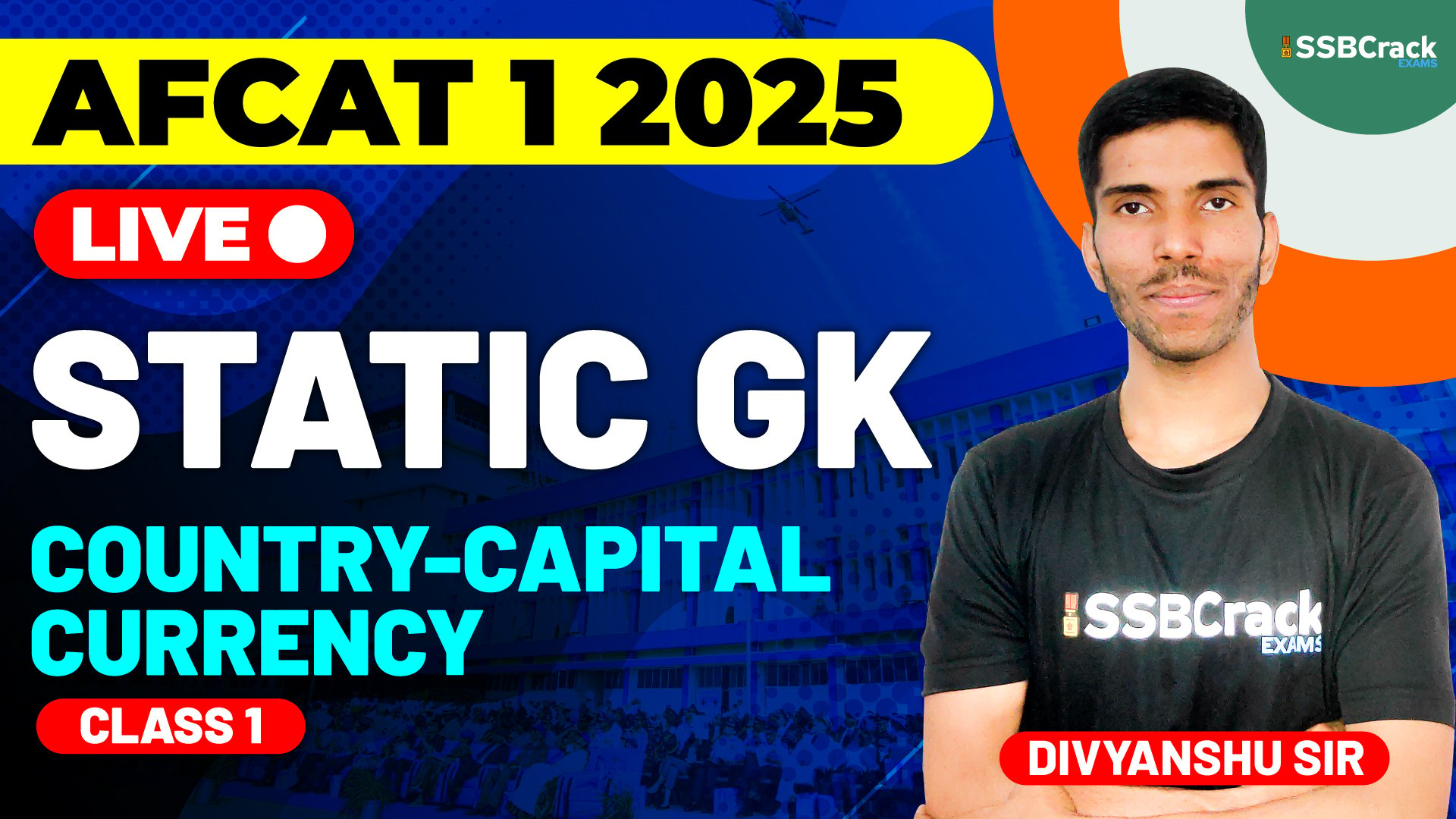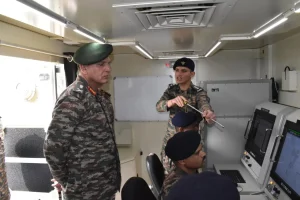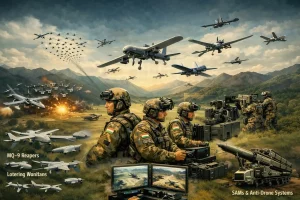In the AFCAT 1 2025 exam, General Knowledge (GK) is a crucial section, and candidates are expected to be well-versed in international geography, including country capitals and currencies. This knowledge is essential as it reflects an understanding of the global political and economic landscape, which is important for aspiring defense personnel. Here’s a detailed guide on some of the most significant countries along with their capitals and currencies.
AFCAT 1 2025 Exam Static GK – Country, Capital, and Currency Class-1
Why Country, Capital, and Currency Matter for AFCAT Exam
Country, capital, and currency knowledge is a recurring topic in the General Knowledge sections of competitive exams. Familiarity with this topic not only boosts one’s static GK but also contributes to understanding the economic and diplomatic relevance of each nation in today’s globalized world. For defense personnel, such knowledge is particularly valuable given the need for awareness about global alliances, economic partnerships, and geopolitical issues.
Key Countries, Capitals, and Currencies
Below is a comprehensive list covering various continents and including both major powers and significant allies of India:
| Country | Capital | Currency |
|---|---|---|
| India | New Delhi | Indian Rupee (INR) |
| United States | Washington, D.C. | US Dollar (USD) |
| United Kingdom | London | Pound Sterling (GBP) |
| Japan | Tokyo | Japanese Yen (JPY) |
| China | Beijing | Renminbi (RMB, CNY) |
| Russia | Moscow | Russian Ruble (RUB) |
| France | Paris | Euro (EUR) |
| Germany | Berlin | Euro (EUR) |
| Canada | Ottawa | Canadian Dollar (CAD) |
| Australia | Canberra | Australian Dollar (AUD) |
| Brazil | Brasília | Brazilian Real (BRL) |
| South Africa | Pretoria (executive), Cape Town (legislative), Bloemfontein (judicial) | South African Rand (ZAR) |
| Saudi Arabia | Riyadh | Saudi Riyal (SAR) |
| United Arab Emirates | Abu Dhabi | UAE Dirham (AED) |
| Singapore | Singapore | Singapore Dollar (SGD) |
| New Zealand | Wellington | New Zealand Dollar (NZD) |
| Switzerland | Bern | Swiss Franc (CHF) |
| Turkey | Ankara | Turkish Lira (TRY) |
| South Korea | Seoul | South Korean Won (KRW) |
| Italy | Rome | Euro (EUR) |
Breakdown by Regions
1. Asia
Asia is home to some of the world’s largest and most economically powerful countries, many of which share strong diplomatic relations with India. Knowing these capitals and currencies can help with a better understanding of India’s regional interactions.
- India – New Delhi (Indian Rupee)
- Japan – Tokyo (Japanese Yen)
- China – Beijing (Renminbi)
- South Korea – Seoul (South Korean Won)
- Singapore – Singapore (Singapore Dollar)
- Saudi Arabia – Riyadh (Saudi Riyal)
- United Arab Emirates – Abu Dhabi (UAE Dirham)
2. Europe
Europe is a continent of both individual and collective significance in global politics and economics, with the Euro serving as a common currency among many countries in the region.
- United Kingdom – London (Pound Sterling)
- France – Paris (Euro)
- Germany – Berlin (Euro)
- Italy – Rome (Euro)
- Switzerland – Bern (Swiss Franc)
- Russia – Moscow (Russian Ruble)
3. Americas
The Americas include some of the world’s leading economies and trade partners. Knowing the capitals and currencies of these countries can be useful for understanding North-South American ties with India.
- United States – Washington, D.C. (US Dollar)
- Canada – Ottawa (Canadian Dollar)
- Brazil – Brasília (Brazilian Real)
- Mexico – Mexico City (Mexican Peso)
- Argentina – Buenos Aires (Argentine Peso)
4. Africa
Africa’s significance has grown in terms of strategic partnerships and resources. India has developed strong ties with several African nations, enhancing diplomatic and economic relations across the continent.
- South Africa – Pretoria, Cape Town, Bloemfontein (South African Rand)
- Egypt – Cairo (Egyptian Pound)
- Nigeria – Abuja (Nigerian Naira)
- Kenya – Nairobi (Kenyan Shilling)
- Ghana – Accra (Ghanaian Cedi)
5. Oceania
Oceania, led by Australia and New Zealand, plays a unique role in the Asia-Pacific region, especially in trade and defense cooperation with India.
- Australia – Canberra (Australian Dollar)
- New Zealand – Wellington (New Zealand Dollar)
- Fiji – Suva (Fijian Dollar)
- Papua New Guinea – Port Moresby (Papua New Guinean Kina)
Currency Symbols and Codes
For the AFCAT exam, it’s also helpful to be familiar with the currency symbols and codes of these nations:
| Currency | Symbol | ISO Code |
|---|---|---|
| Indian Rupee | ₹ | INR |
| US Dollar | $ | USD |
| Euro | € | EUR |
| Pound Sterling | £ | GBP |
| Japanese Yen | ¥ | JPY |
| Swiss Franc | CHF | CHF |
| Canadian Dollar | C$ | CAD |
| Australian Dollar | A$ | AUD |
| UAE Dirham | د.إ | AED |
| Saudi Riyal | ر.س | SAR |
Tips for Memorizing Capitals and Currencies
- Group by Continents: Start by learning countries in regions. Grouping them helps in retaining the information better.
- Use Mnemonics: Create acronyms or sentences to remember capitals and currencies. For instance, “Jolly Penguins Chase Rabbits” could help remember Japan – Tokyo (Yen), Pakistan – Islamabad (Rupee), China – Beijing (Renminbi), Russia – Moscow (Ruble).
- Practice Quizzes: Regularly test your knowledge with quizzes to reinforce memory.
- Flashcards: Create flashcards for each country with the capital and currency on the reverse side for quick revisions.
- Stay Updated: Occasionally, countries may change their currency or capital. For instance, Indonesia has proposed moving its capital from Jakarta to Nusantara. Keeping up with current events will help ensure accuracy.
Importance of This Knowledge for AFCAT Aspirants
Understanding countries, capitals, and currencies offers insight into international relations, economic stability, and global markets. For defense aspirants, this knowledge also provides context about diplomatic engagements, defense alliances, and trade relations that are essential to India’s strategic interests.
Conclusion
Country, capital, and currency knowledge is a fundamental part of static GK for the AFCAT 1 2025 exam. With the right study techniques, candidates can retain this information effectively and perform well in the exam. Focus on key countries and allies of India, and ensure regular revision to stay sharp on this topic.


















